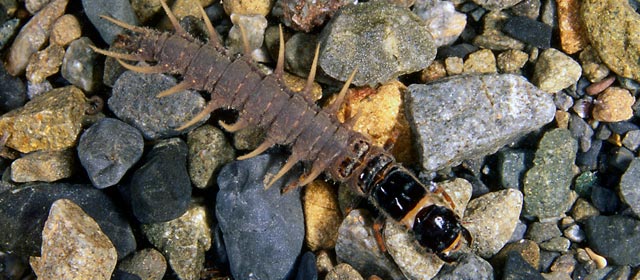Story summary
New Zealand’s lakes, rivers and ponds are home to many living things, although some are so small we can’t see them. They include plants, snails, insects, shellfish and fish.
Freshwater ecosystems
The things that live in and around fresh water form communities or ecosystems. They depend on each other for survival.
The freshwater food chain
The plants and animals in the freshwater ecosystem are linked in a food chain:
- Millions of tiny plants use sunlight to grow.
- These plants are food for sponges, mussels and other plant-eating creatures (herbivores).
- Herbivores are eaten by carnivores – animals that eat other animals. They include dragonflies, snails, birds, eels and other fish, and humans.
- Some species are omnivores – they eat both plants and animals.
Plants
Plants are the first link in the food chain. They also provide cover for smaller species.
Phytoplankton are one type of algae that live in the water, while other types of algae live on lake and river beds. They convert sunlight to organic matter (food) for other plants and animals.
Some mosses and ferns grow in lakes or slow-moving rivers. Mosses grow as deep as 60 metres in the clear lakes of the South Island.
Animals without backbones (invertebrates)
Freshwater invertebrates include sponges, worms, snails, insects such as dragonflies, and shellfish. They mostly feed on living and dead plants in the water, but some also eat other creatures.
In turn, invertebrates are eaten by fish and birds. The native freshwater kōura (crayfish) and kākahi (mussels) are traditional food for Māori.
Fish
New Zealand has over 40 native species of freshwater fish, including whitebait, eels, torrentfish, bullies and a flounder. Some of them are near the top of the food chain: they eat invertebrates, and also other fish.
Surviving in fresh water
Insects, fish and other species have features that help them live in fresh water.
- In swift rivers, some insects use the flow to drift downstream and find food.
- Others build nets to catch food from the water as it flows past.
- Some organisms have hooks to attach them to the riverbed.
- To stay afloat in lakes, phytoplankton use air bubbles, or have spines.
Water pollution
Farming causes damage when soil, and nutrients from fertilisers, are washed into the waterways. This can cause carpets of water weeds (algal blooms) to spread, reducing oxygen for fish and other species.
Farm irrigation reduces the amount of water in streams and lakes. This can also harm water quality.
Hydroelectric dams alter the river systems, and can restrict fish movement.





